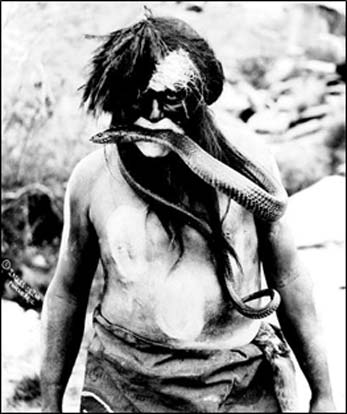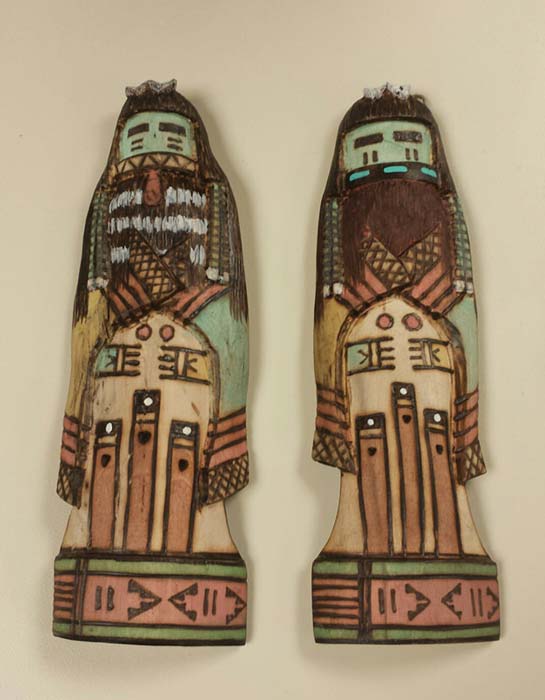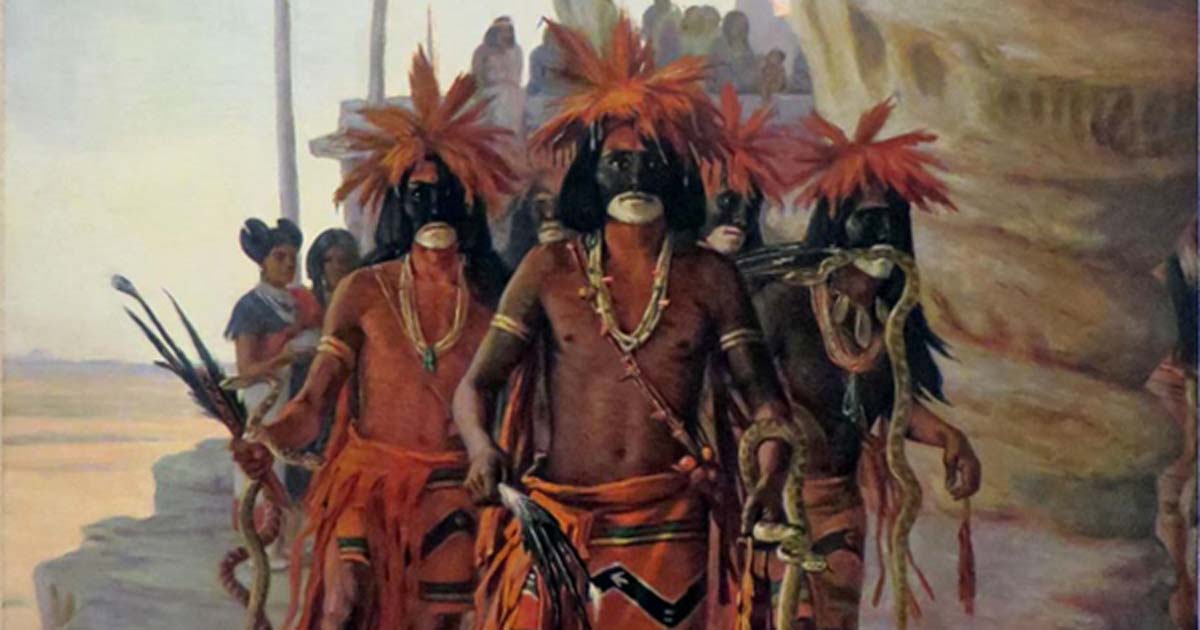Dances with Snakes: The Real Reason for the Hopi Snake Dance
For thousands of years the Hopi tribe of northern Arizona has performed a secretive, sacred ceremony that embodies the manifold and richly evocative archetypal nature of the serpent. In modern times the so-called Snake Dance ( Tsu’tiki or Tsu’tiva) has gained notoriety, partly because its participants put live snakes in their mouths and wrap them around their necks. The species, both venomous and non-venomous, might include garter snakes, gopher snakes, bull snakes, sidewinders, and even rattlesnakes.

Hopi Snake dancer, 1924, northern Arizona. (Author provided)
Hopi Ophis
The Hopi believe that their intimacy with rattlesnakes and other ophidian species engenders rainfall and fecundity upon the high desert. On the other hand, it certainly does not represent the demonic element as displayed in most Pentecostal Christian churches.
The biennial native ritual is held every other August during years that alternate with the Flute Ceremony.
In even-numbered years, the Snake Dance occurs in the villages of Oraibi and Hotevilla on Third Mesa, and in Shongopovi and Shipaulovi on Second Mesa; in odd-numbered years, it is held in Mishongnovi on Second Mesa and Walpi on First Mesa, with the latter village retaining the strongest tradition.
This ceremony cannot actually be considered serpent worship, or ophiolatry. It is instead a plea for agrarian fertility and monsoon moisture in a stunningly beautiful but harsh desert landscape. The sixteen-day ritual—some accounts claim only nine days—encourages the final maturity of the crops (mainly corn, beans, and squash) during the annual agricultural cycle.
- Help Find the Missing Corner of the Hopi Tablet To Prove Their Creation Story: Seeking Answers in the Chapel of the Tablet, Africa
- Hopi Prophecy and the End of the Fourth World - Part 1

Cobs of corn. (Sam Fentress/CC BY SA 2.0)
After being gathered from each of the four directions (northwest, southwest, southeast, and northeast, in that order), the snakes are individually “baptized” by washing them with milky yucca-root suds, which possibly symbolizes seminal fluid. These messengers of the underworld must be pure enough to carry the prayers of the people to the ancestor-spirits below. They must also be clean enough to place between the dancers’ teeth.
The ritual is called the Snake-Antelope Ceremony because it involves both the Snake society ( Tsuutsu’t) and the Antelope society ( Tsöötsöpt)—note the phonetic similarity of the two terms. In the kiva, which is a (semi-) subterranean, communal prayer-chamber, the Antelope priests construct an altar in the form of a mandala-like sand-mosaic. This commonly measures about 30 inches (76.2 cm) square with an effigy of a cougar facing east in the center and four differently colored snakes along the sides. The colors of the sand correspond to the four types of corn and the four directions: yellow/northwest, green (or blue)/southwest, red/southeast and white/northeast. Also seen in the mosaic, issuing from four rows of semicircular clouds, are four zigzag lightning-snakes, each made with its symbolic color and each with a triangular head and a curved horn on the side of the head.

Sand mosaic, Walpi, 1897. Photo by James George Wharton.
The curved sticks in clay balls along the edge represents the bent backs of deceased elders. (Author provided)
Duke University anthropologist Weston La Barre (1911 – 1996) interprets this symbology.
“…the Hopi make quite an arbitrary connection, in a complex symbolism, of snake-phallus-arrow-lightning, in their own explicit statements. Weapons symbolize the warriors’ specific maleness, they say; the warrior gods, of whom the warriors are representatives, are explicitly ithyphallic; the images of the gods are made of lightning-struck wood; the lightning-snake is the arrow of the gods; and the lightning striking the cornfields is the act of fertilizing them.”
The warriors ( qalèetàataqt), who make prayer-sticks ( pahos) for the Snake Dance shortly after the winter solstice, also provide a male medicine made from various roots for the August ceremony. “The reason for using ‘man medicine’ of the Warriors is that the Snake ceremony is not only a prayer for rain but an exhibition of manliness and fearlessness. The baldric of the Warrior Chief, which is a belt worn diagonally across the chest, is then coiled up on the figure of the cougar, and the medicine-bowl of the Warriors is set on it. (The ‘bowl’ is a piñon-gummed Apache basket.)”

Warrior Kachina and Redbeard Longhair Kachina - by R. Numkena, Hopi 2nd Mesa, AZ. (anneheathen/CC BY 2.0)
Orion Synchronization
For the Hopi, the primary winter constellation is Orion. They and other pueblo peoples associate stars, Orion in particular, with warfare. His belt is sometimes conceptualized as a warrior’s baldric, or bandolier. E. C. Parsons observes: “Orion’s belt is thought of as a bandolier ( to’zriki), for the constellation is a war chief ( kahletaka).” Orion dominates the heavens at midnight in the winter, but he also appears at dawn in the summer after his late spring absence of a couple months when he was sojourning in the underworld and was thus invisible to living humans.
Researcher Richard Maitland Bradfield discusses the constellation’s importance to the Hopi. “The night sky over north-eastern Arizona is brilliantly clear, and Orion is a great constellation, only rivaled at this latitude by the Plough turning around the pole star to the north and by the Scorpion lying low on the southwesterly horizon; but when Orion is up, it dominates the sky over the Hopi villages, both by its scale and by the magnitude of its individual stars.”

Constellation Orion as it can be seen by the naked eye. ( CC BY SA 3.0 )
Returning to the Antelope altar, we see that it is both a representation of the cosmos, or an imago mundi, and a re-creation of it. Author Frank Waters writes in this regard:
“The whole altar complex represents the world as it was formed by earth, air, water, plant life, and mankind; and each step of its construction is accompanied by songs that describe the formation of the world and its occupation, and by purification by sacred water. The songs are secret, no outside person being allowed to hear them.”
- Kásskara: Sunken Land of the Hopi Ancestors
- Stonehenge and the Hopi: Hidden Messages Connecting Sacred Sites

Snake Dance at Walpi with spectators, “Snake Rock” on the left. (Author provided)
Before midnight on the eleventh day of the ceremony, the marriage of the Snake Maiden and Antelope Youth takes place, symbolically merging the two societies. Directly following this, the chanting of sacred songs ( pavásio) occurs. Sung in “an unknown foreign language” for the benefit of the snakes themselves and not for the people, these songs continue in the kiva until Orion rises to hover upon the eastern horizon.
From the village of Shongopovi on August 21, 1100 AD (the approximate initial construction of large pueblos on the Hopi Mesas), Orion rose above the eastern horizon about 1:30 a.m., and Sirius in Canis Major cleared the horizon about 3 a.m. Here we see a major Hopi ritual synchronized by these primary constellations. The winter solstice ceremony called Soyal is also synchronized by the appearance of Orion, this time as it is seen at the meridian in the overhead hatchway of the kiva shortly after 1:00 a.m. on December 21st.

Orion, Taurus, Lepus and Part of Canis Major (Sirius and Murzim). (nate2b/CC BY NC ND 2.0)
The day prior to the final Snake Dance performance in the plaza, before sunrise with Orion and Sirius rising, two warriors of the Snake society make several circuits around the Snake and Antelope kivas, each with a bull-roarer (tovokìnpi) and a lightning-frame, which respectively represent the thunder and lightning of the monsoon storms that begin in July and continue into August and early September. These weather phenomena are also associated with the Hopi sky god Sótuknang.
Part 2 : The Day of the Snakes
Top Image: Detail of ‘Hopi Snake Dance’ by Cornelia Cassady-Davis. Source: Granger Meador/CC BY NC SA 2.0
References
Hopi-English Dictionary of the Third Mesa Dialect, edited by Kenneth C. Hill, Emory Sekaquaptewa, Mary E. Black, and Ekkehart Malotki (Tucson: University of Arizona Press, 1998), p. 650, p. 598.
Edward S. Curtis, Frederick Webb Hodge, editors, The North American Indian: Hopi, Vol. 12 (Norwood, Massachusetts: The Plimpton Press, 1922), p. 135.
Malotki, Hopi Dictionary, op. cit., p. 654, p., 645.
Curtis and Hodge, The North American Indian, op. cit., pp. 144-145.
Weston La Barre, They Shall Take Up Serpents: Psychology of the Southern Snake-Handling Cult (New York: Schocken Books, 1969, 1962), p. 100.
Malotki, Hopi Dictionary, op. cit., p. 460, p. 368.
Curtis and Hodge, The North American Indian, op. cit., p. 145.
Parsons quoted by Richard Maitland Bradfield, An Interpretation of Hopi Culture (Derby, England: privately published, 1995), p. 323.
Ibid., pp. 287-288.
Frank Waters and Oswald White Bear Fredericks, Book of the Hopi (New York: Penguin Books, 1977, 1963), p. 291, pp. 222-223. This “foreign language” has been identified as Keresan of either the Acoma or the Zia (Sia) pueblo. Waters mistakenly writes “western horizon” rather than eastern horizon.
Malotki, Hopi Dictionary, op. cit., p. 609.
Mischa Titiev, Old Oraibi: A Study of the Hopi Indians of Third Mesa (Albuquerque, New Mexico: University of New Mexico Press, 1992, reprint 1944), p. 151.
Bethe Hagen, “Timbre of the Spheres,” http://missionignition.net/bethe/timber_of_the_spheres.php.
John G. Bourke, Snake-Dance of the Moquis: Being a Narrative of a Journey from Santa Fe, New Mexico to the Villages of the Moqui Indians of Arizona (Tucson: The University of Arizona Press, 1984, 1884), p. 114. In my previous books I have claimed that the proto-Aztecs were called the Chichimecs (“People of the Dog”), who first lived in the American Southwest, particularly at Chaco Canyon, and later migrated into the Valley of Mexico to become one of the most powerful tribes centered around Tenochtitlán, now Mexico City.
Malotki, Hopi Dictionary, op. cit., p. 142, p. 504.
See Chapter 7, Gary A. David, The Orion Zone: Ancient Star Cities of the American Southwest (Kempton, Illinois: Adventures Unlimited Press, 2006), pp. 151-167.
Jesse Walter Fewkes, Hopi Snake Ceremonies (Albuquerque: Avanyu Publishing, Inc., 2000, 1986, reprint of Tusayan snake ceremonies, Sixteenth Annual Report to the Bureau of American Ethnology, 1897), p. 304.
See my article “A Hopi Hero’s Journey: How the Snake Clan Came to Arizona” on the Ancient Origins website, http://www.ancient-origins.net/myths-legends-americas/hopi-hero-s-journey-how-snake-clan-came-arizona-009125

Event Information: Summer Solstice Chaco Canyon



















